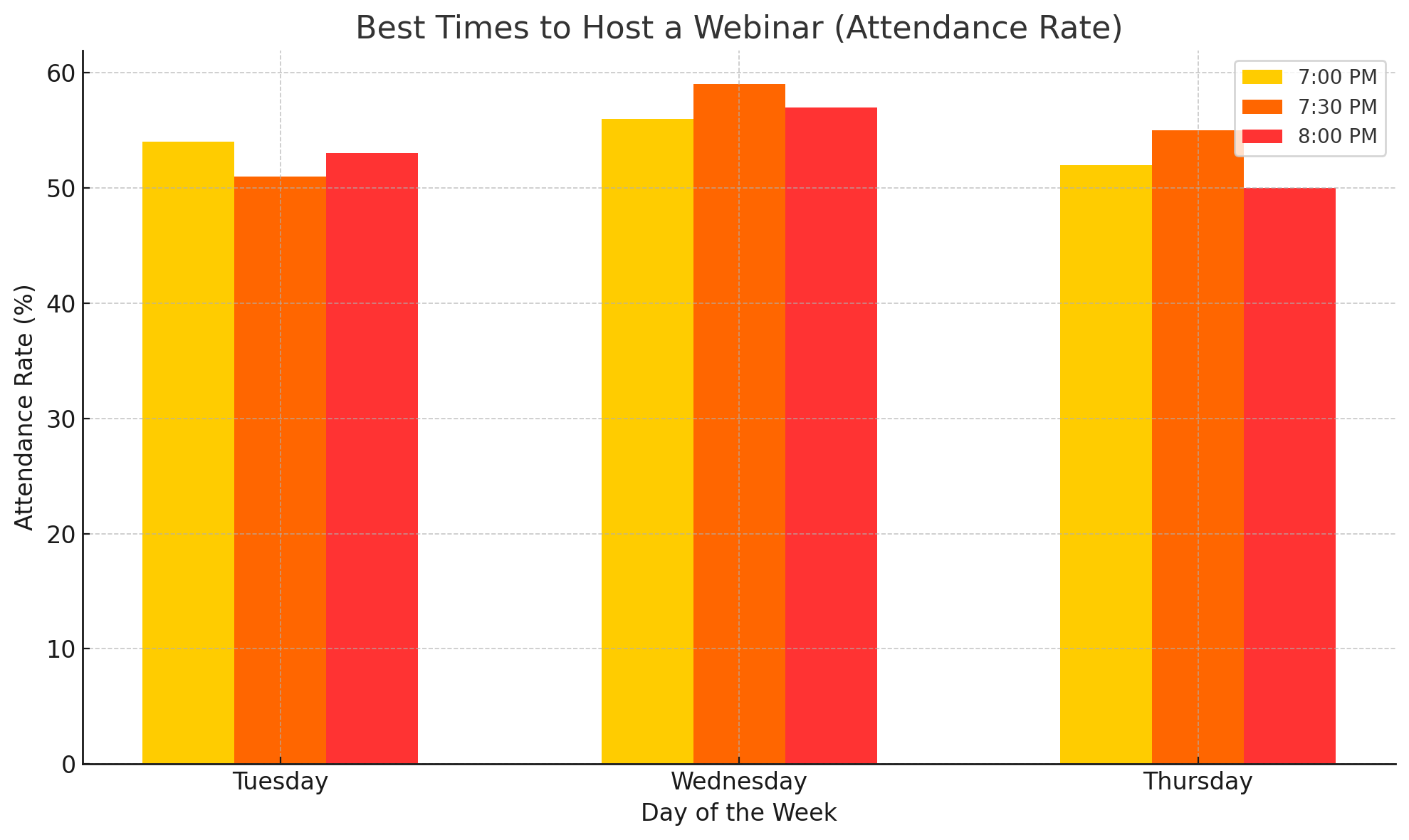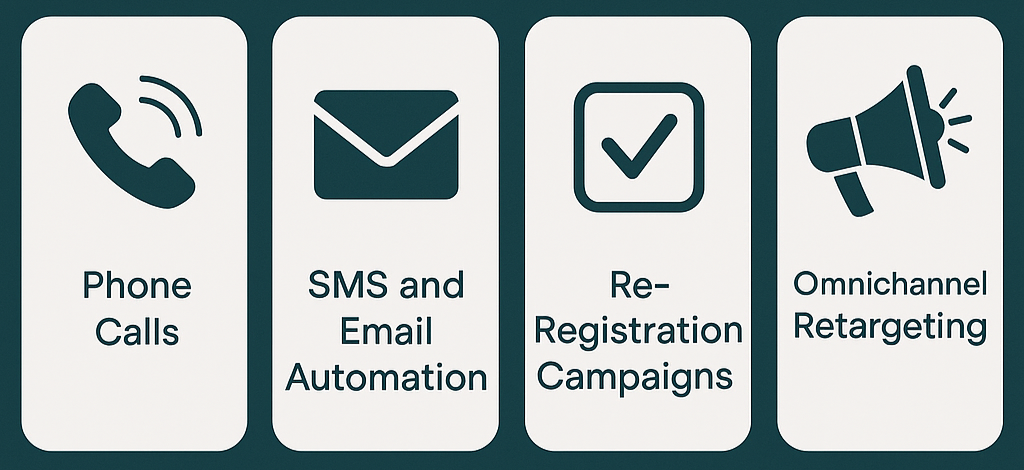
What is a Real Estate Webinar?
A real estate webinar is essentially an online event where real estate professionals, like agents and mortgage brokers, can meet with potential clients, share valuable insights, and help educate their audience, all without leaving their office. These sessions are usually held via platforms like Zoom and can cover various topics, from tips for first-time homebuyers to current market trends or different mortgage options available. The beauty of these webinars is that they allow real estate professionals to engage directly with a specific audience, build credibility, and generate leads, all while eliminating the limitations of in-person events. It's a fantastic opportunity to reach people across different locations and connect in a meaningful, interactive way.
Webinars have become one of the most powerful lead generation tools for real estate agents and mortgage professionals. In fact, 85% of businesses consider webinars essential to their marketing strategy. For agents, webinars can attract high-intent prospects, build trust at scale, and fill your pipeline with qualified leads - all without leaving your home office. But running a successful webinar requires more than just picking a topic and firing up Zoom. You need to consider when to schedule it, how to promote it, how to engage your audience, what tech setup to use, and what to do before and after the live session. This guide will walk you through everything you need to know before hosting a webinar as a real estate agent or mortgage professional, let’s dive in!
Table of Contents
- Choosing the Best Time to Host Your Webinar
- Picking the Right Webinar Topic for Your Audience
- Promoting Your Webinar: Why Meta Ads Beat Google Ads
- Webinar Presentation Tips for Success
- Structuring Your Webinar Content
- Essential Tech Setup for Your Webinar
- Pre-Webinar Reminders and Automation
- Live vs. Pre-Recorded Webinars
- Post-Webinar Follow-Up Strategies
- Why Webinars Are the Future of Real Estate Marketing
1. Choosing the Best Time to Host Your Webinar
Timing is everything when it comes to webinars. The goal is to schedule your session when the maximum number of target attendees can show up. Mid-week webinars tend to perform best - Wednesdays are the top day for live webinars, with Tuesdays and Thursdays close behind.
Time of day matters too. For a consumer audience like home buyers or property owners (which most real estate webinars target), evenings tend to work better since people are off work. Many successful real estate webinars start around 7:00–7:30 PM. This captures people after dinner but before they unwind for the night.
That said, know your demographic. If you’re targeting an older crowd, you might schedule the webinar earlier in the day when they’re most attentive. On the other hand, in certain locales you must avoid conflicts - for example, if many in your area attend church on Wednesday nights, don’t schedule webinars then. If you’re in a major city like New York or Chicago with commuters, consider starting a bit earlier to accommodate busy schedules. The key is to align with your audience’s routine.

2. Picking the Right Webinar Topic for Your Audience
Choosing a compelling webinar topic is crucial - it should address a real need or interest of your target audience. In real estate, nothing is off the table when it comes to webinar topics, but success can be area-dependent. Think about the common questions or challenges clients face in your market, and build a webinar around solving those.
When brainstorming topics, focus on value and specificity. A generic “real estate webinar” is less enticing than “How to Buy Your First Home in 2025 Without Breaking the Bank” or “5 Secrets to Selling Your Home Faster in [Neighborhood].” The more your webinar promises to solve a problem or teach something actionable, the more registrations you’ll get. Also, highlight what makes you uniquely qualified - weave in brief testimonials or success stories to build credibility. By picking the right topic and framing it around your audience’s needs, you set the stage for a well-attended webinar that attracts high-intent leads.
3. Promoting Your Webinar: Why Meta Ads Beat Google Ads
Having a great webinar planned is one thing, now you need people to show up. This is where promotion and advertising come in. While you can share your webinar via email lists or organic social posts, targeted advertising will fill your seats faster. So, which ad platform should you use? In today’s landscape, Meta (Facebook/Instagram) is often the go-to choice over Google Ads for webinar campaigns aimed at consumers. Here’s why:
- Faster Algorithm & Targeting: Meta’s algorithm is highly advanced and learns your target audience very quickly, whereas Google Ads typically requires a longer “learning period” to optimize.
- Quick Promotion Cycles: Because Meta finds the audience quickly, you don’t need to run ads for too long. In fact, the typical webinar ad campaign runs just 5–7 days before the event.
- Cost-Effectiveness: For many real estate use cases, Facebook is cheaper than Google. The cost-per-click on Facebook is often lower than on Google for real estate leads, meaning you can get registrations without breaking the bank.
- Ad Creative and Platform Reach: On Meta, your ads appear in a social feed, allowing you to use engaging images or videos to grab attention. You’re essentially interrupting someone’s scroll with an offer to solve a problem.
Pro tip: On Facebook, use a Lead Form ad if you want to make registration super quick - it lets people sign up for your webinar without leaving the app. Or, direct them to a simple landing page. Either way, keep the sign-up form short - name, email, maybe phone. The easier the process, the more conversions.
4. Webinar Presentation Tips for Success
So you’ve got people registered, now you need to deliver an amazing webinar. This is where many fall short: they treat a webinar like a casual Zoom chat or, worse, they read off slides with zero energy. To ensure your webinar actually converts viewers into clients, follow these presentation best practices:
- Know Your Material Inside-Out: This is the biggest factor. Don’t wing it. The most engaging webinar hosts are confident in their content because they prepared. Practice, practice, practice your presentation multiple times before the live event.
- Inject Your Personality: Remember, people do business with people they like and trust. Especially in real estate, home buyers and sellers want an agent or lender they “gel” with - buying or selling a home is a huge life decision, and nobody wants a dull guide through that process.
- Engage Your Audience Throughout: A webinar shouldn’t be a one-way lecture. Plan ways to interact and keep attention high. By being engaging and interactive, attendees will pay closer attention, and you’ll stand out from boring competitors.
- Use a Clear, Confident Voice: Speak in a loud, clear tone - you want everyone to easily hear and understand you. Enunciate your words, and avoid rushing through content.
- Focus on Value, Not Fluff: Respect your attendees’ time by delivering on the promises you made in your registration. If you said you’ll cover 5 tips or 7 mistakes, cover them thoroughly and concretely (give examples, data, quick case studies).
By following these presentation tips - preparation, personality, engagement, clarity, and value - you’ll set a professional yet relatable tone. Your goal is for attendees to finish the webinar feeling like “Wow, I learned a lot and I really like this agent/professional”. That emotional connection and trust is what makes them willing to take the next step with you.
5. Structuring Your Webinar Content
How you organize your webinar is just as important as how you present it. A logical, persuasive structure will guide your audience from “interested” to “ready to work with you.” Here’s an ideal webinar structure that many successful real estate and mortgage professionals use:
- Introduction (Welcome & Agenda): Start by greeting everyone warmly and thanking them for coming. Briefly introduce yourself with a one-liner about who you are and your expertise. Then set expectations: tell them what the webinar is about and what value they will get.
- Testimonials & Credibility Boosters: Before diving into the core content, spend a few minutes on why attendees should trust you. This can include a short personal story of your experience or success rate, client testimonials, or even quick case studies.
- The Core Content (Educational Value): This is the meat of your webinar - the tips, strategies, or insights you promised. Make this section compelling by breaking it into clear sub-points. For each point, explain the concept, give a concrete example or story, and then advise how to apply it or avoid a pitfall.
- Throughout the Webinar - Invite Action: Do not wait until the very end to mention your services or invite them to talk to you. A best practice is to promote your booking link or offer multiple times throughout the webinar - aim for a total of eight or more mentions, according to our own team’s findings. This isn’t as excessive as it sounds if you spread it naturally.
- Q&A Segment: After delivering your core content and key takeaways, transition to a Q&A. Encourage questions and give people a moment to type them in. To spark engagement, you should prepare a few FAQs yourself in case the audience is shy.
- Final Call-to-Action (The Pitch): After Q&A, deliver your closing call-to-action clearly and confidently. This is where you explicitly invite attendees to book an appointment / strategy call or whatever your next step is. Because you seeded this throughout, it won’t feel pushy - it will feel like a natural next step.
This structure - intro, credibility, core content, ongoing CTAs, Q&A, and final pitch - flows from building interest → delivering value → inviting action. It mirrors a funnel: attract them with education, warm them up, and convert them with a well-timed offer. Executed well, many attendees will be eager to talk with you by the end.
6. Essential Tech Setup for Your Webinar
One great thing about webinars is you don’t need a TV studio or fancy equipment to look professional. In fact, you can keep your tech setup quite simple. Here are the essentials and a few tips:
- Reliable Computer and Internet: Use a good laptop or desktop computer that can handle streaming video without lag.
- Second Monitor (Optional but Helpful): If possible, set up a dual-monitor configuration. This allows you to run your presentation on one screen while keeping the webinar controls, attendee list, or speaker notes on the other.
- Camera and Audio: You do not need an expensive camera. The built-in webcam on a modern laptop or a basic external HD webcam is sufficient. Just position it at eye level and make sure your face is well-centered and visible.
- Lighting: Lighting can make the difference between looking like a pro or a silhouette. Don’t rely solely on natural light, as it can change or fade. Set up a light source in front of you to illuminate your face.
- Quiet Environment: Choose a quiet, distraction-free space for broadcasting. Let family or roommates know not to interrupt. Put your phone on silent. Eliminate background noises if possible.

The goal is to appear clear, audible, and professional. By handling the tech basics, you can focus on delivering value without worrying about glitches. As the saying goes, “Keep it simple,” especially when you’re starting out. You can always upgrade gear later, but many agents run highly successful webinars with just these simple tools.
7. Pre-Webinar Reminders and Automation
Getting people to register for your webinar is only half the battle, you also need them to actually show up on the day. On average, only about 35–45% of registrants attend live, but with the right reminder strategy you can bump that up significantly. The key is to use automation to send timely reminders and create a sense of urgency leading up to the event.
Here’s a proven reminder timeline you can implement:
- Immediately After Registration: As soon as someone signs up, send a confirmation email and/or text message. Thank them for registering, reiterate the webinar date/time, and most importantly, provide the join link and an option to add to their calendar.
- One Day Before Webinar: Send a reminder email the day before, roughly 24 hours out. In the message, remind them why they signed up.
- The Night Before (SMS Text): The evening prior, send a short text to those who provided a phone number. Texts feel personal and are almost always read - they help cut through email overload.
- 1 Hour Before Webinar: Send another email one hour before start. This is a final nudge to get them prepared.
- 10 Minutes Before Webinar: Send a text message 10 minutes out. This hits them right when they might be distracted or on the fence about attending.
- At Webinar Start Time: You can even have the system send one more text exactly at go-live. Some people literally forget or lose the link, so this catches stragglers.
- During Webinar (if applicable): Some advanced setups might even auto-text those who haven’t joined by, say, 15 minutes into the webinar. This might sound like overkill, but when done in a friendly way it can coax a few extra attendees who intended to come but got sidetracked.
Leverage automation tools to handle all this. If you’re using a marketing CRM (like WebinarCRM), you can set up an automated workflow: once someone registers, they get put into an email/SMS sequence that sends these reminders at the specified times. This is one of those lead generation automation tools that make life easier for a busy real estate agent - it ensures every registrant gets nurtured without you manually sending messages each time. By webinar day, your attendees will feel informed and excited, and you’ll likely see over half of your sign-ups eagerly tuning in.
8. Live vs. Pre-Recorded Webinars
You might be wondering, should you host the webinar live every time or use a pre-recorded webinar? There are pros and cons to each, and in fact some of the most efficient agents leverage pre-recorded webinars to scale their outreach without sacrificing results.
Live Webinars are great for real-time interaction. You can address audience questions on the fly, tailor examples to the audience in the room, and create that “we’re all here together” energy. Some clients respond better knowing it’s truly live, they feel it’s more authentic, and they like being able to talk to you in the moment.
Pre-Recorded Webinars, on the other hand, offer huge advantages in efficiency and consistency. A pre-recorded webinar is essentially an “evergreen” webinar that you record once and then set to play for attendees on a schedule or on-demand.
Pre-recorded webinars are an excellent option once you’ve mastered your webinar presentation and want to scale. They work the exact same way as live webinars in terms of funnel: people register, watch, and convert - only you’re not tied to the event time. By investing a bit of time to set up a polished recording and an automation platform, you can exponentially increase how many prospects you reach without increasing your workload.
9. Post-Webinar Follow-Up Strategies
Time for an important truth: the webinar isn’t over when you end the Zoom call. In fact, the real magic often happens after the webinar in your follow-up process. Many webinar hosts make the mistake of thinking the job is done and then simply sending a generic “Thank you for attending” email. Not you - you’re going to capitalize on all that interest you just built!
Consider this: industry experts note that roughly 80% of conversions from webinars happen during the follow-up, not on the live webinar itself. People often need an extra nudge or a reminder afterwards to take action.
Here’s how to execute a strong post-webinar follow-up:
- Same-Day “Thank You” & Replay: Send an email to all registrants within a few hours after the webinar. Thank them for attending. Provide a replay link so they can watch the recording.
- Personal Follow-Up (Calls/Texts): This is where the real winners separate themselves. Within 24-48 hours after the webinar, call your attendees individually, or at least the hottest ones (those who engaged a lot or explicitly said they want help).
- Multi-Day Email/SMS Sequence: Beyond the immediate thank you, set up a sequence of follow-up touches over the next week or two.
- Retargeting Ads: If you’re savvy with ads, you can run a Facebook retargeting campaign specifically to those who registered for your webinar. This keeps your face and offer in front of them.
- Invite to Next Webinar or Content: Not everyone will convert immediately, and that’s okay. Some might not be ready to buy or list for months, but you want to keep them in your ecosystem. In later follow-ups or newsletters, you can invite them to future webinars or send them useful content.

The overarching principle: Be proactive and consistent, not pushy. You don’t want to spam or harass, but you also shouldn’t be shy. These leads signaled interest, they want guidance. By following up diligently, you’re actually providing great customer service.
10. Why Webinars Are the Future of Real Estate Marketing
If you’ve made it this far, you can probably tell we’re passionate about webinars, and for good reason. Webinars are not just a trendy tactic; they’re a fundamental shift in how real estate professionals are growing their businesses, especially in the post-2020 world. Here’s why embracing webinars now will put you ahead of the curve:
- Consumer Preferences Have Changed: Since the COVID-19 pandemic, people have grown accustomed to doing more online, and they like it. From virtual home tours to Zoom meetings, consumers realized they can get things done from the comfort of home. Attending a webinar is easy and comfortable. Attendance rates for webinars shot up during the pandemic and remain high - companies saw an 87% increase in webinar attendance after 2020 and that trend continues upward.
- Wider Reach, Lower Cost: A physical seminar in your town might attract a couple dozen people if you’re lucky, and you’re limited by geography. A webinar, on the other hand, can attract hundreds from all over your metro area or even globally if relevant. You’re not limited by room size or location.
- High Engagement = Warmer Leads: Webinars uniquely combine the scale of one-to-many marketing with the engagement of personal interaction. During that 45-60 minutes, you have your audience’s attention in a way that blog posts or social media blurbs can’t match. They’re hearing your voice, seeing your face, asking you questions. This builds a relationship and trust much faster.
- People Value Education First: Real estate transactions involve big decisions and emotions. By hosting webinars, you position yourself as an educator and advisor first, not just a salesperson. This is the core of an “education-first” marketing approach.
In conclusion, webinars encapsulate the way forward: convenient, cost-effective, scalable, and relationship-oriented marketing. They allow you to work smarter, not harder - reaching dozens or hundreds of prospects in one shot, leveraging automation to handle the follow-up, and ultimately converting clients in a consistent, predictable way. As we highlighted in a recent industry guide, the real estate agents winning in 2025 are those educating prospects before selling to them and building trust at scale through video. That’s exactly what your webinar will do. So if you’re not yet using webinars as part of your lead gen strategy, now is the time to start. Those who adapt early will lead the market, while others wonder how you’re signing so many clients “out of nowhere.” In reality, you’ll know it’s because your webinar funnel is working behind the scenes to turn interested attendees into loyal customers.
Ready To Grow Your Commissions?
Let’s launch your next growth chapter together. Reach out today and see how RECO Demand’s education-first webinar funnels turn browsers into booked appointments and propel your real estate or mortgage business toward consistent six and seven-figure results. Your pipeline transformation begins with one click.








